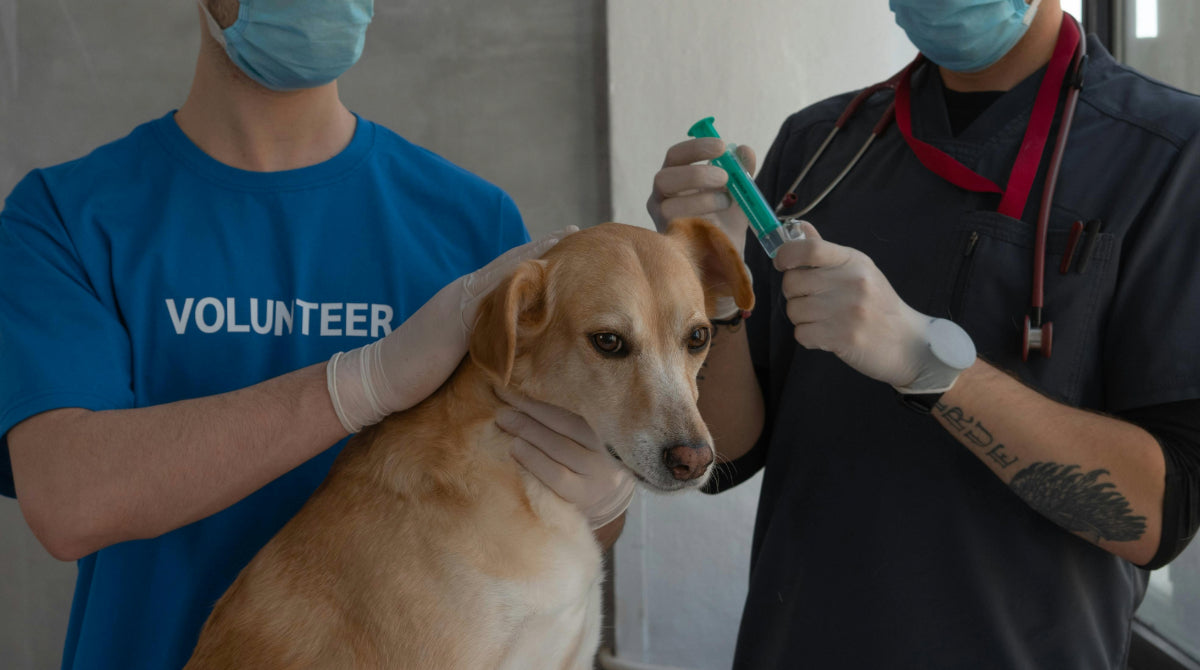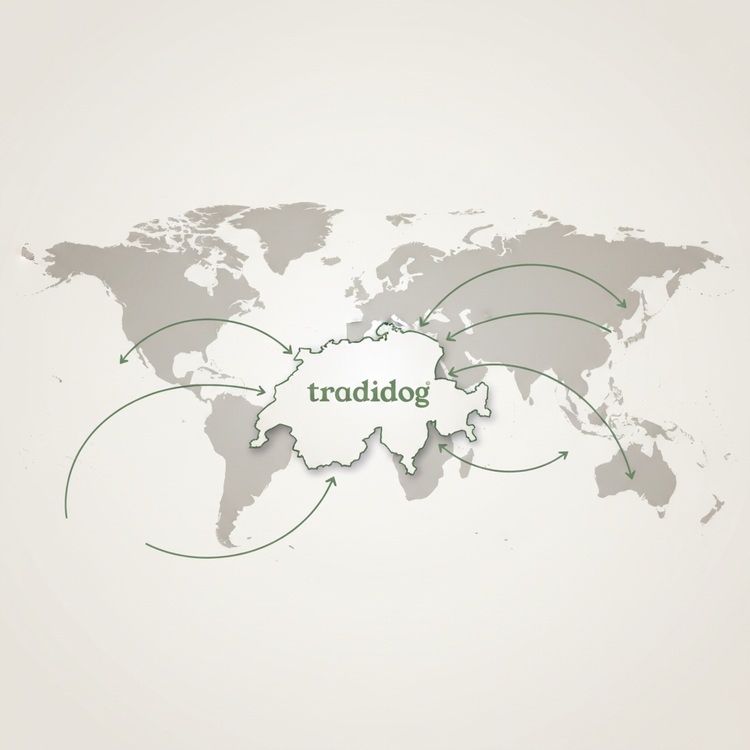
Vomiting in dogs
Vomiting in dogs is something every dog owner will likely encounter sooner or later. Whether it's the half-chewed sock your four-legged friend secretly devoured or the typical "grass snack" from their last walk, a gagging dog is rarely a pleasant sight. But as unpleasant as it may be, vomiting is often an important warning signal from the body.
Dogs have a very sensitive digestive system, which can raise alarm bells faster than you think. Sometimes it's just something minor, like a food gobbled down too quickly. But it can also be a sign that something more serious is afoot. And that's where you come in: With a little knowledge, you can help your dog get back on their feet faster—and maybe even avoid the occasional gagging incident.
So let’s take a look together at what lies behind the topic of “vomiting in dogs” and how you can best deal with it when your furry friend presents the contents of his stomach again.
Causes of vomiting in dogs
Vomiting in dogs can have many different causes. While some reasons are harmless and don't require significant attention, others can indicate serious health problems. Identifying the cause is the first step in helping your dog.
More harmless causes:
- Eating too quickly : If your dog devours his food too quickly, it can overload his stomach, leading to vomiting.
- Eating grass : Many dogs occasionally eat grass, which can irritate the stomach and trigger vomiting. This is often a natural response to cleanse the stomach.
- Changing food : A sudden change in food can upset your dog's sensitive stomach. A gradual transition is recommended.
- Stomach irritation : Sometimes fatty or difficult-to-digest food can put a temporary strain on the stomach.
Serious causes:
- Poisoning: Consuming toxic foods or household chemicals can cause vomiting.
- Gastrointestinal infections : Bacteria, viruses, or parasites can infect your dog's gastrointestinal tract.
- Foreign body in the stomach : If your dog swallows objects that the body cannot digest, this can lead to a blockage.
- Organic diseases : Diseases such as kidney failure, liver problems or pancreatitis can also cause vomiting.
Acute or chronic vomiting?
Not all vomiting is the same. There's an important distinction between acute and chronic vomiting that you should know. This distinction will help you better assess whether your dog has simply eaten something wrong or whether there's a more serious problem.
Acute vomiting:
- Occurs suddenly and usually lasts only for a short time.
- Often triggered by something your dog has recently eaten, such as unfamiliar food, grass, or spoiled food.
- Often harmless if it is a one-time event and no further symptoms occur.
Chronic vomiting:
- Recurrent vomiting over days or weeks.
- Could indicate serious health problems such as gastritis, inflammatory bowel disease, kidney disease or even tumors.
- A visit to the vet is essential to find the cause and begin appropriate treatment.
Vomiting or regurgitation?
Not everything your dog throws up is vomiting. There's an important distinction between vomiting and regurgitation that many dog owners don't know. Both processes look similar, but have different causes and require different treatment.
Vomit:
- Active process : Your dog often shows signs of nausea such as drooling, restlessness, or gagging. He vomits forcefully, and the contents may contain partially digested food, bile, or mucus.
- Common causes: stomach irritation, infections or other organic problems.
Regurgitation (regurgitation):
- Passive process : The dog simply regurgitates food or liquids without any visible effort. This often happens shortly after eating.
- The regurgitated contents are undigested and look similar to the food.
- The cause could be a problem in the esophagus, such as megaesophagus. (See explanation below)
Input: Megaesophagus refers to a condition in which a dog's esophagus is enlarged and dysfunctional. The esophagus's normal function is to transport food from the mouth to the stomach through wave-like muscular movements (peristalsis). In megaesophagus, this function is impaired or completely lost. As a result, food accumulates in the enlarged esophagus instead of being passed on to the stomach.
If you are unsure which process your dog is experiencing, a veterinarian can help you tell the difference.
What to do if your dog vomits?
If your dog is vomiting, it's important to stay calm and proceed systematically. There are some simple steps you can take to help your dog quickly and determine if veterinary attention is necessary.
First measures:
- Fasting : Withhold food for about 12 to 24 hours to allow the stomach to settle. However, be careful not to let your dog become dehydrated.
- Water intake : Ensure your dog has access to small amounts of water. Large amounts could re-irritate the stomach.
Observe your dog:
- Watch for other symptoms such as lethargy, diarrhea, fever, or bloody vomit.
- If the vomiting stops after a short time and your dog otherwise appears normal, it is probably a harmless event.
When should you go to the vet?
- If vomiting occurs repeatedly or is accompanied by other symptoms.
- If your dog seems apathetic or shows signs of pain.
- If poisoning is suspected or if your dog has swallowed a foreign object.
Timely veterinary treatment can in many cases prevent more serious complications.
Poisoning and foreign bodies
Dogs are naturally curious and often explore their surroundings with their mouths. This can lead to them swallowing dangerous or indigestible substances. Vomiting is a common symptom of poisoning and when your dog has ingested a foreign object. Therefore, it's important to recognize these risks early and act accordingly.
Poisoning:
- Common toxins: chocolate, grapes, raisins, onions, garlic, alcohol, human medications.
- In addition to vomiting, symptoms may include diarrhea, tremors, seizures or collapse.
- Act immediately : If you suspect that your dog has ingested something poisonous, contact a veterinarian or poison control center immediately.
Foreign body:
- Dogs tend to swallow things like toys, bones, or household items.
- Signs: Sudden vomiting, loss of appetite, abdominal pain or constipation.
- A foreign body can block the intestine and often requires surgical removal.
Food intolerances and allergies
Not every dog tolerates every food equally well. Some dogs develop intolerances or allergies to certain ingredients in their food over time. These can manifest as repeated vomiting or other symptoms. Recognizing and avoiding these triggers is crucial for your dog's well-being.
Food intolerances:
- Some dogs are sensitive to certain proteins, grains or additives in their food.
- Symptoms: Vomiting, diarrhea, flatulence, itching or skin problems.
Allergies:
- In addition to vomiting, symptoms such as skin rashes, ear infections or severe itching often occur.
- In such cases, you can conduct an elimination diet under veterinary supervision to identify the food that is causing the allergy.
Hypoallergenic food:
- There are special diets designed for dogs with sensitive stomachs or allergies. These can help alleviate symptoms.
Something you should have known for some time now: We at Tradidog are the experts when it comes to food supplements. So be sure to check out our products and support your dog in leading a healthy life.
Prevention: How to prevent vomiting in dogs?
Prevention is better than cure – this saying also applies to vomiting in dogs. Many causes can be prevented with careful care and monitoring. With a few simple measures, you can help keep your dog healthy and prevent vomiting from occurring in the first place.
Feeding habits:
- Avoid feeding your dog large amounts at once. Divide the food into smaller portions throughout the day.
- Use anti-gulping bowls to prevent eating too quickly.
High-quality nutrition:
- Make sure your dog gets a balanced, high-quality food that meets his needs.
Regular health care:
- Have your dog dewormed and vaccinated regularly.
- Routine veterinary checkups can help detect health problems early.
Take care of the environment:
- Remove poisonous plants from your garden and keep your dog away from garbage.
- Make sure your dog doesn’t eat anything unknown while walking.
With these preventative measures, you can protect your dog from many potential problems and give him a healthy and happy life.

Conclusion
We want you, as a dog owner, to enjoy your healthy dog. (Just like the one above.) We therefore draw the following conclusion:
Vomiting in dogs can have many causes, from harmless triggers like eating too quickly to serious illnesses or poisoning. Psychological factors such as stress or anxiety can also play a role. It's important to identify the cause: Acute, one-off vomiting is often unproblematic, while chronic vomiting or additional symptoms such as lethargy or bloody vomit require veterinary evaluation.
With a balanced diet, regular preventative care, and stress reduction, you can often prevent vomiting. Monitor your dog closely and act quickly if necessary to provide the best possible support.
Tradidog motto: The best comes last, for healthy dogs Tradidog is a must!
Share

